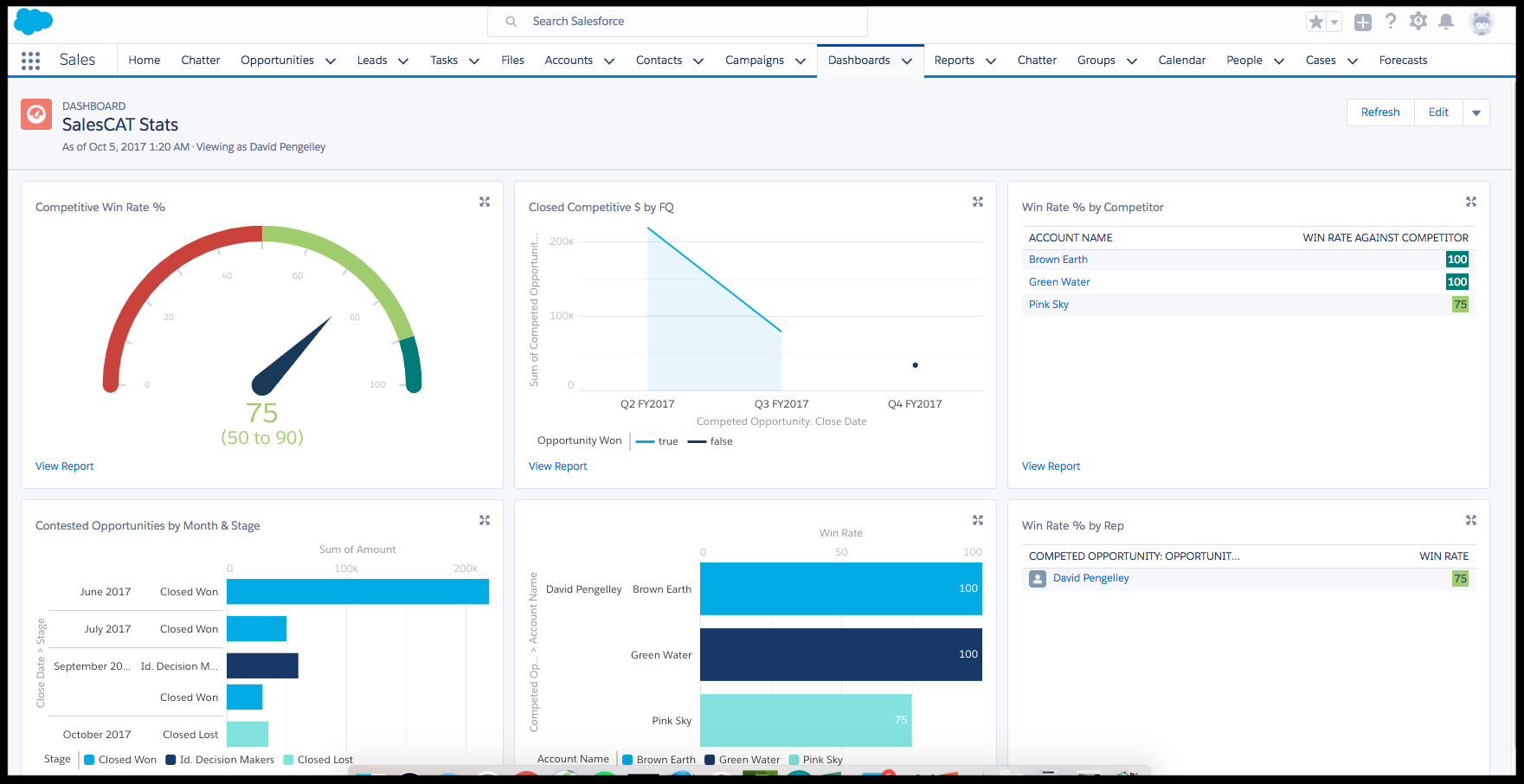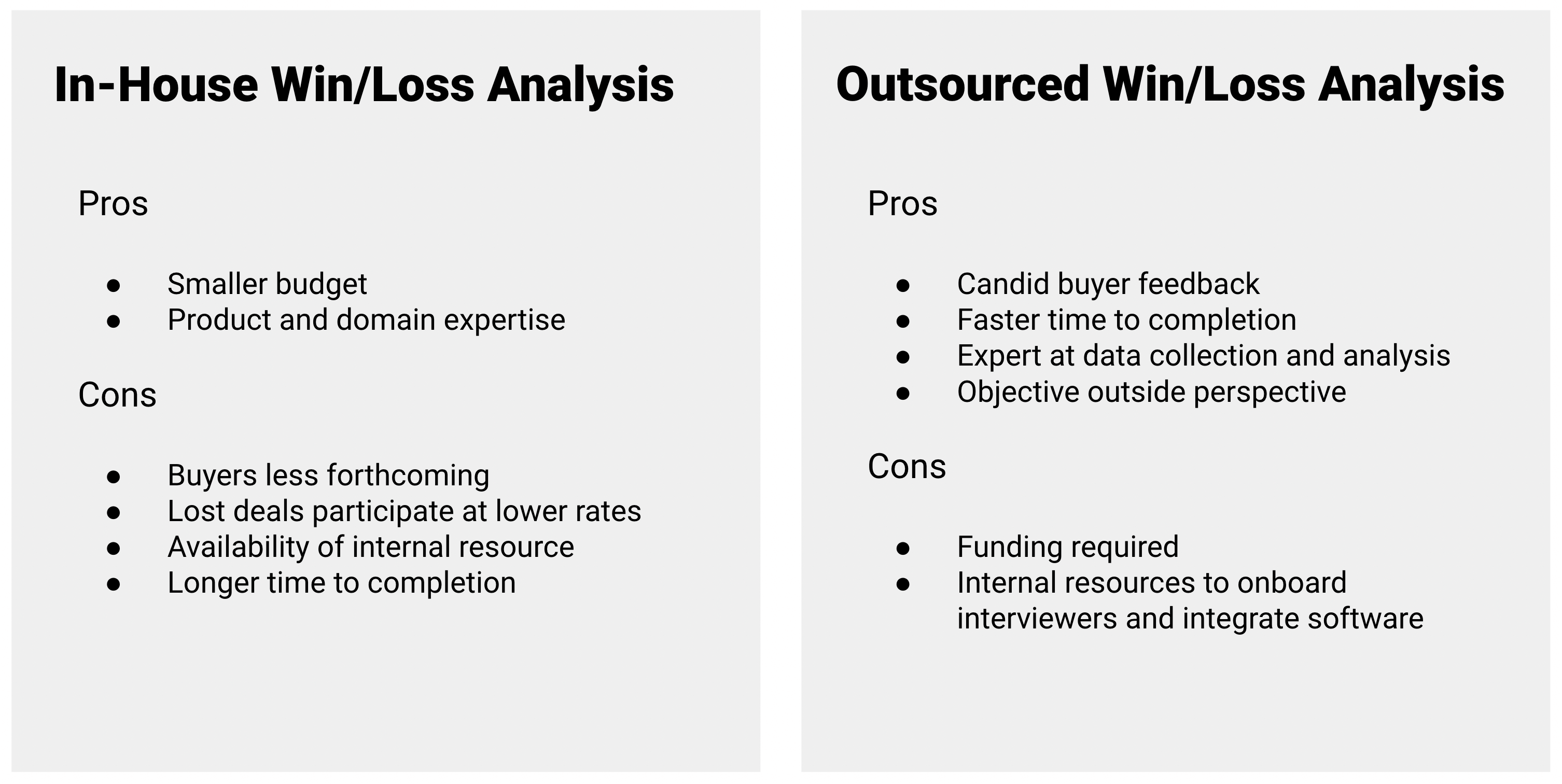Sales win loss analysis helps sales leaders make data-driven decisions. What’s working and where can we double-down? What isn’t working, and how do we fix it?
Sales win loss analysis is a data-based, empirical approach to identifying and understanding the issues that drive sales outcomes.

How Sales Win Loss Analysis Programs Start
Sales win loss analysis programs often begin by analyzing data sourced by sales teams. The three most common “entry-level” approaches are:
-
- Win loss analysis in Salesforce. Closed reason codes and metrics like overall win rate and win rate segmented by competitor can be reported natively in Salesforce or with sales analytics apps on the AppExchange. But bad CRM data is an issue.
- Lost deal reviews put key losses under the microscope. They reveal a lot of detail about a small number of individual deals but don’t provide the “meta” view across multiple deals that’s needed to make changes to product roadmap, pricing, and messaging.
- Conversation Intelligence applications like Gong, Chorus, and Zoom IQ for Sales identify winning patterns and provide coaching insights for individual reps. But gaps in the data make them less useful for complex sales that involve large buying groups and field sales.
These three approaches are a good starting point, but they’re not actionable beyond the individual seller or deal.
Impactful Change Requires Actionable Insights
Bigger, more impactful changes to sales process, product roadmap, and competitive positioning require a deeper understanding of the issues.
Salesforce win loss analysis can identify increasing losses to a specific competitor. And with closed/lost reason codes those losses can be tied to a capability gap. But product teams won’t find the buyer’s use case and detailed capability assessment in the CRM or a lost deal review. Conversation intelligence can mine emails and calls to provide some insight, but the most reliable data will come from buyers outside the sales process.
Up-leveling With Buyer Interviews
Win/loss interviews close the loop on buyer assessments of marketing and sales interactions, and a vendor’s product offering.
In many organizations the first buyer interviews are done by product marketing, product management, or customer success. But interviewing buyers requires significant time and experience. Gartner reports that “Internally run and managed programs can take the majority of a devoted resource for at least a quarter’s worth of time.”
Once interviews begin, the word spreads fast. We find interest in buyer feedback spread both laterally across teams and up and down the hierarchy at Growth Velocity’s clients. Use cases grow. Cadence changes from one-time to continuous.
Check “How To Conduct A Win/Loss Analysis” for an overview of the seven-step process we use ourselves.
This early success leads many organizations to assess outsourcing the win/loss program. They want to improve interview quality, shorten delivery time, and expand to continuous data collection rather than one-time.

How Rigorous Sales Win Loss Analysis Improves Sales Performance
Sales performance improves when organizations level up on sales win loss analysis. Todd Berkowitz at Gartner found that:
Those that take a more comprehensive approach have seen a 15% to 30% increase in revenue and up to 50% improvement in win rates.
We’ve found three capabilities that drive this sales performance improvement.
1. Competitive Intelligence
Win/loss buyer interviews provide sellers with a reliable, in-depth understanding of how buyers assess each competitor’s market position and strategy, sales execution, and product capabilities.
Buyer interviews also enable better objection handling by revealing how actual buyers in won deals overcame concerns about weak points. This enables sellers to reference what’s actually worked for other buyers as they handle a competitive weakness.
2. Coaching, Training, And Tools
Buyer interviews provide an independent perspective on the individual seller’s performance and how it compared to the work of competing sellers.
Sales win loss analysis also identifies issues that recur across multiple deals and multiple sellers. These gaps can require updating the sales process and training. Growth Velocity has helped teams identify and understand how competitors have outperformed them on responsiveness, demo/POC quality, leadership participation, contracting, and understanding the buyer’s needs.
Buyer surveys can be used to track whether buyers perceive changes in the sales engagement, and whether the changes are an improvement or not.
3. Internal Alignment
Oftentimes in maturing and mature companies there are disconnects between product, marketing, and sales, and the gaps in understanding can lead to slower pipeline generation, longer sales cycles, and deal loss. Sales win loss analysis helps bridge these teams with a ‘meta’ view of the business and how it goes to market.
Imagine the perfect scenario where pricing and demand generation, product roadmap, sales strategy and buyer engagement are unified around what’s actually working and not working in the market right now. This is possible at early-stage companies, but with growth these teams fractionalize and often work at cross- and even counter-purposes. As a company grows, alignment becomes more difficult to manage, and external resources become necessary to define the current ‘truth’ that goes to market.
Here an overall net-impact-view across multiple deals helps clarify priority fixes to GTM strategy, product roadmap, and sales process. Teams have greater confidence that these are the right changes to make. In-depth buyer feedback shows exactly where the gaps are, and makes it easier and faster to fix them.
Final Thoughts
Entry-level approaches to sales win loss analysis fall short of supporting impactful changes to sales process, product roadmap, and competitive positioning. Neither CRMs or lost deal reviews provide the detailed buyer feedback required for big GTM improvements.
Buyer interviews surface competitive intelligence, align go-to-market teams, and help identify where coaching and training tools can improve individual and company-wide sales performance.
Gartner has found “a 15% to 30% increase in revenue and up to 50% improvement in win rates” for organizations that take a more rigorous approach to sales win loss analysis.
Related Posts
Win/Loss Analysis Reports: 3 Things You’ll Learn
Which aspects of your product offering and buying experience are helping drive sales? And which aspects are hindering sales? This is what enterprise and mid-market software companies often struggle to understand. A good win/loss analysis report will provide the answers to these questions.
Three Reasons Sales Leaders Want Even More Data About Their Buyers
While B2B sales teams are literally swimming in data, it’s not enough. Data-driven sales leaders are using input directly from buyers to find new ways to improve win rate and lead with conviction.
Data Driven Targeting And Messaging Increases Profitability
Sales and marketing are typically the largest area of spend for an expansion stage company. Marketing leaders can support increased profitability by reassessing who the strongest buyers are, and developing innovative and data driven ways to target them.




